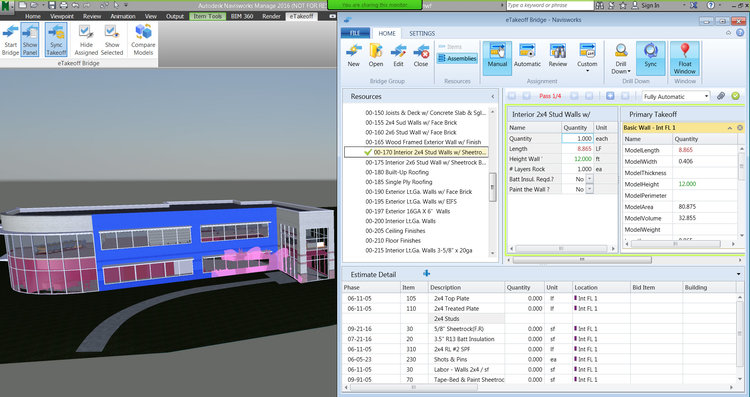
BIM’s been around long enough now that it’s no surprise that leaders in the construction software ecosystem continue to look for ways to capitalize on its possibilities. One of the more popular ideas that has really gained traction lately is 5D BIM, which ties cost and estimation processes directly to the 3D models created by designers. But, how does 5D BIM work exactly? What are the benefits? What are the roadblocks to wider adoption?
To find out, we spoke with Walter Davis, estimating market manager at Sage. He explained some of the basic concepts behind 5D BIM, the many benefits it provides estimators, how his company’s own 5D BIM software works, and how it’s helping to solve some of the “software silo” challenges of the AEC industry.

So, very basically, how is 5D BIM different from 3- and 4D BIM?
BIM is centered around 3D design and modeling, accomplished through many different types of 3D software solutions; 2D is the name given to a flat representation of a building project. Today, 2D drawings can be an output of a 3D model, which provides a digital version that can be measured using 2D software to take off the quantities and measurements from the drawings. As the 3D model changes during the life of a project, additional 2D digital drawings can be created to provide up-to-date information to owners and contractors.
4D BIM adds time to the mix. It allows owners and contractors to visualize the status of a project at different points in time, both past and future. It helps contractors manage site-related activities and visualize the impacts of changes, which can also help them understand potential risks.
5D BIM is where cost analysis and budget tracking come into play. By incorporating cost estimating into the BIM ecosystem, initial information and changes made to the 3D model can more quickly and accurately be transferred to a building estimate and, once construction has begun, to the operational project budgets. 5D BIM is where Sage Estimating enters the picture.
Are there dimensions to BIM beyond the fifth?
Yes, and while not universally agreed upon, 6D and 7D BIM are all about continuing the information linkage between various disciplines in a building’s life-cycle, centered around building operation, maintenance, and energy consumption. There are many components in a BIM ecosystem, which, prior to now, have all been treated separately in software silos.
So it sounds like 5D BIM is meant specifically for estimators?
5D BIM automation implies that the costing software used by an estimator has access to the data contained in a 3D model. One of the most time-taking and error-prone activities performed by estimators is a process called takeoff. This is literally the process of taking off measurements and quantities from a set of drawings. Generally this process has involved physical blueprints or, today, digital versions of those blueprints.
Being able to access this information in a 3D model, without manually measuring or counting everything in the project, well, you might imagine that it can multiply an estimator’s productivity by an order of magnitude.
And that’s just the beginning. In the past, estimators provided one or two estimates before a project went to bid. Cost estimates were event-driven—that is, by bid or negotiation. Today, due to the availability of sophisticated 3D solutions, owners can view and make changes to a project throughout the design phase, generating many changes along the way. Each time, a new estimate is required, turning the estimate from an event-driven to an iterative process. Having the ability to compare changed models to each other and automatically flow the cost impacts into an estimate are critical to the success of 5D BIM.
“There are many components in a BIM ecosystem, which, prior to now, have all been treated separately in software silos.
From what I’m reading, a lot of estimators are still relying on 2D plans for takeoffs. Why is 5D BIM still struggling to gain traction?
First, the adoption of digital 2D drawings has really gained acceptance in the industry, and the software’s gotten very good. Today you can do many things with 2D software that were unthinkable in the beginning.
Second, there is always information that the architect or engineer doesn’t include in the 3D model. They don’t always have every piece of information that an estimator needs because he’s looking at it from how to build the job, not how to represent the project on paper. So, estimators must go to their 2D drawings and specs to get the information that’s missing. There may always be a need for some 2D.
BIM is now trickling down from the world’s largest contractors to the medium and upper midsize contractors. Recent studies show that in the coming months, over thirty-two percent of contractors plan to buy software related to BIM. So, the times are changing.
What specific information tends to be missing in these incomplete models?
Things like joist hangers. You’ve got all this piping that has to be run in a building, and the engineer has designed where and how the piping is laid out. He’s very careful that he doesn’t have any clashes with other structures within the building. But, the engineer doesn’t really go through the model and say, ‘Well, I need a hanger every so many feet for that project.’ The estimator looks at the model, and he knows he’s going to have to have joist hangers, and he knows that they can be a significant cost component of the estimating project. That’s something he thinks about because he’s looking at what the project’s going to cost to get built, whereas the engineer’s really more concerned about the technical buildability.
When you’re talking about software development occurring in silos, is there particular software that has trouble talking to other software?
When you start trying to marry together three-dimensional, graphical software with estimating, where there’s long been a database-oriented type of software solution that is not graphical, the software is written in a different way to approach those different needs. To create a seamless integration between those two types of software requires some ingenuity and some imagination.
Today, you’ll see some of the newer, up-and-coming software development companies in the industry that have said, “You know what? It’s just too hard to try to work with all these different software providers. We’re going to build something that does everything, all under one umbrella.” But this ignores the fact that some highly specialized products, like Autodesk Revit, for instance, have been in the marketplace for a long time and have a large, satisfied user base. That user base is not particularly interested in leaving their trusted solutions. They just want their different solutions to talk to each other.
Are you or other estimation-software firms taking action to get designers to include more estimating-related information in their 3-D models? Is there a push for more model uniformity from designers?
These are tough questions, but yes. As BIM becomes increasingly adopted, more and more necessary information will be included in the models. This will probably be led by the design-build contractors, due to their closeness to the project. As to uniformity of models, this is difficult to imagine ever being totally solved. That said, we were founding members of the International Alliance for Interoperability—known today as Building Smart—which pushes hard for software companies like ours to work together toward interoperable solutions for the common good.
How long do you think it will be before the use of 5D BIM is commonplace among estimators?
Well, I think as time goes by and the tools get better and the integration between the various disciplines gets better, that’s what’s going to help make it more commonplace. And, as general contractors decide that they want to work more seamlessly with their subs, they will want to provide them with 3D drawings, and they will want quicker responses and more consistent, accurate responses, driving even more BIM adoption. Some of it’s just an evolution that will force change. Some of it, I think, will be driven by better software tools and better pricing in the marketplace.
Talk a little bit about Sage’s own 5D BIM approach. How does it work?
Over the years, [there was a] realization that we were not going to be the builders of CAD software and/or the really high-end project-management software. We needed to be able to use—and approach as allies, really—the top producers of those kinds of applications. We’ve developed what we call a best-in-class or best-of-breed approach, which says that we, as the leading estimating software in the marketplace, want to make sure that we’ve made ourselves available to work with leading software providers of 3D and project-management solutions.
And how are you going about doing that? How does your software integrate with software such as Autodesk Navisworks?
One of our 2D suppliers, a company called eTakeoff, built a product called eTakeoff Dimension, which was a very good, heavy-duty, production-quality 2D system for estimators. They built a product called Bridge that allowed the estimators to sync up their takeoffs with our estimating system. And, by that, I mean they can literally do takeoffs at the front end and have it automatically pointing to the right kinds of items and assemblies in the database. This means that they’re able to do takeoffs and create a cost estimate as they go, without having to manually enter takeoff information into the estimating software. When they built their Bridge product, they had in mind working with objects, which is the technical term for what the data looks like inside of an Autodesk Navisworks 3D model. So, it lent itself to being able to work with information coming from a 3D model.
Recently, we’ve announced the availability of what we call the Navisworks Integrator, which is our ability to take information from the 3D model in Autodesk Navisworks, pass it through Bridge, and automatically attach it inside of an estimate, in the appropriate assemblies and items of the estimate. Basically, a contractor might be using two different versions of 3D software, they might have a couple of different versions of 2D software on-site, and they could potentially all work through the same Bridge and integrate with Sage Estimating.
“[Estimators] can literally do takeoffs at the front end and have it automatically pointing to the right kinds of items and assemblies in the database. This means that they’re able to do takeoffs and create a cost estimate as they go, without having to manually enter takeoff information into the estimating software.
How does your software help solve some of the challenges of 5D BIM work?
One of the challenges we talked about was adoption, and the approach we feel we’ve taken allows an estimator to quickly and easily add tools to their tool chest in terms of things that they can interface with and connect to Sage estimating. If you have a common interface, and it’s something you use every day, then the adoption, we believe, will be higher because it’s natural that if you don’t have to keep learning something new every day, you’ll start to use it and get better at it. Today, with BIM, there is even greater need to share information between software systems.”
Are there other challenges or pain points of 5D BIM work that you hope to address with your software in the near future?
Yes, our estimating solution is sort of like a gateway to information needed during the rest of the life-cycle of a project. At every stage, down the road—energy analysis, facilities management—all of that is involved and rotating around the cost components of both building the project and maintaining the project throughout its life-cycle. So, our attention will continue to focus on interoperability between estimating and other components of the construction software ecosystem.

Discussion
Be the first to leave a comment.
You must be a member of the BuiltWorlds community to join the discussion.